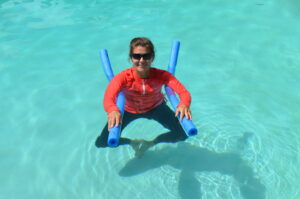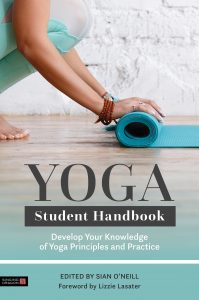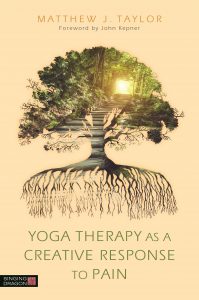
Water yoga, at its essence, is doing the yoga you already know, in the water.
When you think about it a little harder, you realize there’s more to it than that. You can’t sit or go upside down without getting wet. Your yoga mat and most of the other gear you’re used to using isn’t going to work. And maybe you don’t know how to swim, so you have concerns about being in the water. My book, Water Yoga: A Teacher’s Guide to Improving Movement, Health and Wellbeing, breaks down these misconceptions and gets you practicing and teaching water yoga like a pro.
On land, a yoga practice is made up of eight limbs of yoga. In the water, I call the limbs of yoga waves. The concept of the different aspects of yoga being waves fits into the aquatic environment better. It also reinforces the idea that you don’t have to do the parts of yoga in sequential order. Water yoga is very accessible for beginners, and emphasizing the aspects relevant for each person, instead of a rigid hierarchy, is student-friendly.
The first wave of water yoga, the Yamas. Ahimsa is the first Yama and is traditionally translated as non-harming. I translate it as being kind. Being kind to yourself is even easier in the water because of the water’s buoyancy. Buoyancy offloads your weight and relieves sore joints making a water yoga practice easier for many people than a land-based practice.
The Niyamas are philosophical practices we want to do more of. For example, Tapas is about right-effort. All your yoga practices should be done at the right level for you. In the water, if you want to work harder in a posture, you can use the water’s viscosity (water’s thicker than air and harder to move through) and make your movements big and fast. If that vigorous movement hurts, the pain stops immediately when you stop because the water’s viscosity slows you down immediately. On land, managing your momentum and gravity require continued muscular effort, so you continue to ache as you return the heavy weight to the floor. It’s easier to customize your yoga experience in the water.
The wave of water yoga that most people are used to splashing around with is the poses. One of the most common questions, is how do you do Down Dog pose or other inversions without drowning people? Easy, we modify water yoga poses to make the best use of the aquatic environment. The focus is on using the same physical and energetic properties as the poses on land, and less on making them have the exact same shape.
Pranayama, or breath practices, are even more powerful in the water. Hydrostatic pressure is the force that the increased density of the water applies to a submerged body. It also makes your inspiratory muscles work harder, increasing your breath capacity with water yoga.
The hydrostatic pressure also contributes to a Pratyahara practice. The universally applied increase in pressure calms your nervous system, similar to how a weighted blanket is used for neurodivergent kids. Pratyahara is withdrawing your senses to prepare you for meditation. It’s the natural response to getting in the water. When you say, ‘Ah’ and close your eyes because you’re feeling relaxed in the water, that’s exactly what the fifth wave of water yoga is.
Concentrating on a single point, a Drishti, is a Dharana practice. With all the visual movement of the water’s surface, and the hustle and bustle at a pool, there’s a lot to distract you. Dharana is learning to sharpen your focus so all those other things clamoring for your attention don’t affect you. For example, when you’re in a balance posture and focus on a single point far outside the pool, the distractions right next to you won’t impact you as much.
Floating meditation is a Dhyana practice. You’ve withdrawn your focus from what’s happening around you and are focused on just what’s going on inside your head. Just like it’s easier to be reflective and spend time with yourself at the beach, the pool is a natural environment to get to know yourself better and focus on what really matters.
Just like with land yoga, Samadhi or bliss, is your intent with your practice. It’s integrating all eight waves of water yoga as best you can to be comfortable and secure with the most essential aspects of yourself. However, just like with land yoga, in water yoga, you have no guarantee you’ll get there as an outcome. That’s why it’s more important to pay attention to your time in the pool and appreciate the process more than worry about the results.
As a concept, you can’t beat water Yoga. It allows you to enjoy the comfort of the water. Outdoor pools allow you to get outside and enjoy the sun, all while getting the benefits of yoga. Water Yoga: A Teacher’s Guide to Improving Movement, Health and Wellbeing teaches you how to practice all waves of water yoga for yourself as a first step. Then moves beyond that with the tips to guide others through the practice. Once you know how to apply these concepts for yourself, the book helps you with the communication strategies and teaching tips to help your students succeed.
I live with multiple forms of arthritis. Yoga provides me with excellent self-management tools to stay healthy. Water yoga is even better for people who live with arthritis because of the properties of water. My success in managing my arthritis inspired me to become a water yoga teacher and share the practice with you through the book. Use the book for yourself, share it with family and friends, and learn to teach water yoga, because the bottom line is yoga is awesome, but it’s even better when wet.
Christa Fairbrother, MA, ERYT 200/500, is an internationally recognized water yoga coach and trainer. In addition to being a yoga professional, she is certified both as an Aquatic Therapist through the Aquatic Therapy and Rehab Institute and as an Aquatic Fitness Professional through the Aquatic Exercise Association. She combines her background in education, yoga, and aquatics to provide high-quality training for other pros so more people worldwide can get the benefits of water yoga. She lives in Florida with her husband and two sons. When she’s not in the pool, there’s nothing she loves better than a good book and a huge cup of tea.












 Simply put: yes. Yes, there is a need for increased training in the world of yoga, because the focus of yoga that has become the most popular is asana, and asana deals with movements of the human body. And the human body is one complicated and mysterious machine — which is surprisingly easy to break. Now, this doesn’t mean a person can’t teach a good and safe yoga class without further education in related fields, but in order to advance the benefits of yoga by bringing it to a larger population of the world, it would be helpful if the concept of yoga evolved into a more respected and scientific field.
Simply put: yes. Yes, there is a need for increased training in the world of yoga, because the focus of yoga that has become the most popular is asana, and asana deals with movements of the human body. And the human body is one complicated and mysterious machine — which is surprisingly easy to break. Now, this doesn’t mean a person can’t teach a good and safe yoga class without further education in related fields, but in order to advance the benefits of yoga by bringing it to a larger population of the world, it would be helpful if the concept of yoga evolved into a more respected and scientific field.
